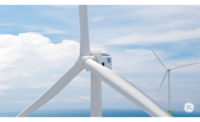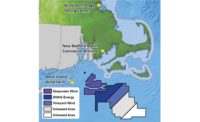A Kiewit Corp. unit will design and build the first U.S.-made offshore wind substation—a 1,500-ton, 60-ft-tall structure to be deployed for the 132-MW, 12-turbine South Fork wind farm that is set for construction off New York’s Long Island, said project developers Ørsted Offshore North America and Eversource Energy on Aug. 25.
Kiewit Offshore Services Ltd., the largest U.S. offshore fabricator, will develop the substation for the state’s first offshore wind farm at the firm's 555-acre oil and gas fabrication facility in Ingleside, Texas, with work set to start in November, it said.
Developers also said Sept. 2 that federal environmental permit review has begun of the adjacent Sunrise project, a proposed 924-MW wind farm, marking "another sign of the tremendous momentum" for U.S. offshore wind. The review by the US Interior Dept., also launches a public comment on the project through Oct. 4
“The production of clean energy is at a pivotal stage in the U.S.,” said Paul Geldmeier, Kiewit Energy executive vice president and president of Kiewit Offshore Services, who is leading its offshore wind work. Substations are critical components of utility-scale offshore wind farms, collecting power produced by turbines and connecting it to the onshore grid. The structure for South Fork will consist of a topside resting on a monopile foundation.
More than 350 workers will support the Kiewit project at the site, as well as in Houston and Kansas, and “hundreds of union workers in the Northeast,” said Kiewit. Joe Nolan, Eversource Energy CEO and president, said the project “signals the growth of the next great maritime industry throughout the country.”
The firms declined to disclose the value of the Kiewit contract.
Ørsted and Eversource said they are set to start construction of South Fork, located 35 miles east of Montauk, N.Y., in 2022, with a federal permit expected early in the year. The U.S. Dept. of Interior's Bureau of Ocean Energy Management issued the project’s final environmental impact statement on Aug. 16. State regulators approved the project's transmission cable to East Hampton, N.Y., earlier this year.
Kiewit plans to complete substation construction by spring 2023. It will travel via the Gulf of Mexico and Atlantic Ocean for installation in summer.
The contractor opened the Ingleside yard, near Corpus Christi, in 2001 to tap into anticipated increased energy drilling activity in the Gulf of Mexico and in deepwater worldwide, with a $100-million capital investment, according to its website. The firm says the yard “specializes in the fabrication and integration of large, complex offshore projects” and has “the largest onshore lifting device in the Western Hemisphere with a rated capacity of 11,000 tons.”
Kiewit is currently working on construction of the 60,000-ton Argos semi-submersible offshore oil platform for energy giant BP, which will be installed in the Gulf about 190 miles south of New Orleans, in 4,500 ft of water. Related to offshore wind, Kiewit's team “specializes in applying the lessons from the international offshore market to reduce risk and bring American innovation to American power,” the website says.
Pushing Forward
The firms announced the offshore wind award during a major sector conference, the International Offshore Wind Partnering Forum, held Aug. 24-26 in Richmond, Va. At the event, Gov. Ralph Northam (D) announced that the state, which aims to be the Mid-Atlantic offshore wind project hub, had reached a deal with Dominion Energy to lease a 72-acre area at the Port of Virginia's Portsmouth Marine Terminal to stage wind turbine foundation assembly for its proposed 2.6-GW Coastal Virginia Offshore Wind project.
Liz Burdock, CEO of the Business Network for Offshore Wind, told 1,000 attendees from an estimated 600 global companies that “in the U.S., we only have eight years” to reach the Biden administration's goal of 30 GW of offshore wind deployed, noting that Europe took 30 years to reach that power output.
Burdock called on federal and state government officials to offer more incentives to expand the offshore wind supply chain and workforce recruitment and to aid in managing project risk. She said BOEM “should reduce its regulatory timeline.”
Interior Dept. Deputy Secretary Tommy Beaudreau told attendees in a video address that assessments of the first round of wind projects raised problems not apparent a decade ago, according to sector publication Workboat.
More Developments
Meanwhile, in a move that could ease some constraints in offshore wind farm development, U.S. Customs and Border Protection issued a ruling Aug. 23 that allows use of both foreign and U.S. certified vessels for the first time for a wind energy project. Under the federal Jones Act, foreign vessels cannot be used for U.S. offshore energy sector transportation between ports.
While the ruling would apply narrowly to the 12-MW New England Aqua Ventus floating wind demonstration project being developed in Maine, it still represents the first Jones Act decision related to the offshore wind sector, says Charlie Papavizas, a partner in law firm Winston & Strawn, which represents Aqua Ventus.
But the U.S. industry's largest approved commercial scale offshore wind project to date, the 800-MW Vineyard Wind facility off Massachusetts that now is in construction, still is the target of opponent lawsuits. Two recently filed in federal district court in Boston against Interior Dept. officials seek to reverse the project permit.
In one suit, Nantucket Island residents and others dispute conclusions of project owners and government reviewers that Vineyard Wind won't harm a nearby endangered whale species. In the other, a solar power developer claims that federal reviews failed to examine safety or engineering issues in the project's use of GE-made, 12-MW Haliade-X wind turbines, including their ability to survive a Category 3 or greater Atlantic hurricane and risks of “catastrophic release of oil and contaminants” from turbine generators in severe coastal weather.







Post a comment to this article
Report Abusive Comment